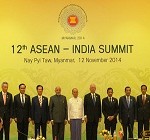At the end of January, officials from India, Nepal, Bhutan, and Bangladesh met in New Delhi to conclude a multimodal connectivity agreement. Sub-regional agreements such as this are increasingly becoming the norm in Asia after Pakistan opted out of rail and road connectivity deals at the SAARC Summit in Kathmandu in November. Over time, these linkages will also feed into the under-construction road and rail projects between India and Myanmar, which is a bridgehead to ASEAN.
While these sub-regions within SAARC—that exclude Pakistan—are crystallising, the importance of the larger Bay of Bengal Initiative for Multi-Sectoral Technical and Economic Cooperation (BIMSTEC) that comprises India, Bangladesh, Bhutan, Myanmar, Nepal, Sri Lanka, and Thailand, is also growing. This grouping—the last of its three summits so far was held in Myanmar in March 2014—now looks like it will develop more quickly as a regional economic zone than a SAARC paralysed by the internal troubles of Pakistan.
The benefits of trade and connectivity are evident. China’s GDP grew dramatically from $176.6 billion in 1979—when it began to open up its economy—to over $10 trillion in 2015. This growth has been inextricably tied to trade—in 1979, China accounted for only 0.7% of world merchandise trade, compared to over 10% today.
Opening up its economy has given China the benefits of over 10% annual GDP growth for the last 30 years, access to global markets, a dominant position in global supply chains, and ready access to energy from trading-partner countries like Indonesia, Malaysia, and Myanmar.
China’s vast trade relationship with its ASEAN neighbours is worth a total of $350 billion, accounting for 14% of the grouping’s annual trade. This has overtaken the U.S.’s economic influence—ASEAN-U.S. trade was worth a relatively lower $207 in 2013.
Moreover, despite occasional exchanges of fire stemming from China’s maritime disputes with countries such as Japan, Vietnam, and the Philippines, their extensive economic interdependencies have ensured that all sides eschew aggravating any confrontation.
In contrast, India, which began economic reforms in 1989, when the country’s total GDP was a little over $300 billion, now has an economy worth only $2 trillion and a 2% share in global merchandise trade. These comparatively low numbers highlight New Delhi’s lack of initiative in promoting trade.
But now, India too is being welcomed into regional trade networks to the East. Apart from an agreement with ASEAN as a grouping, separate agreements with Thailand, Malaysia, and Singapore have been signed. India also has trade agreements with Sri Lanka, South Korea, and Japan.
These agreements have taken India’s trade relationship from only $3.15 billion in 1990 to $80 billion in 2012, accounting for approximately 3% of ASEAN’s trade.
In addition to the benefits of trade itself, India’s eastward outlook is also driven by strategic considerations of the economic and military expansion of China. India is already a member of strategic groupings like the ASEAN Regional Forum, the ASEAN Defence Ministers Meeting, and the East Asia Summit; and it will soon be upgraded from observer to member of the Shanghai Cooperation Organisation.
India is also in the process of upgrading its strategic relations with important middle powers like Vietnam, Japan, and Australia. For example, it is in the process of purchasing defence equipment from Japan, and has extended a $100 million line of credit to Vietnam to enable its purchase of Indian naval ships.
An eastward focus is also necessary for India because it has joined efforts to keep open the shipping lanes in the Indo-Pacific—a need that was reiterated in the U.S.-India Joint Strategic Vision for the Asia-Pacific and Indian Ocean signed in January.
The recent improvement in India’s political relations with Bangladesh and Myanmar is facilitating the construction of infrastructure in India’s northeastern states—this is the crucial element in promoting cross-border trade, and connecting India physically to its east and to ASEAN
Foreign secretary-level talks between India and Pakistan resumed when new foreign secretary S. Jaishankar visited Pakistan on March 3. However, unless political relations between the two countries improve substantially and soon, the incentives for India to expand its economic relationship with Pakistan will diminish because of its growing economic and strategic imperatives in the East, undergirded by the growing trade networks with East Asia and South East Asia.
Neelam Deo is Co-founder and Director, Gateway House: Indian Council on Global Relations; She has been the Indian Ambassador to Denmark and Ivory Coast; and former Consul General in New York.
This article was exclusively written for Gateway House: Indian Council on Global Relations. You can read more exclusive content here.
For interview requests with the author, or for permission to republish, please contact outreach@gatewayhouse.in.
© Copyright 2015 Gateway House: Indian Council on Global Relations. All rights reserved. Any unauthorized copying or reproduction is strictly prohibited


